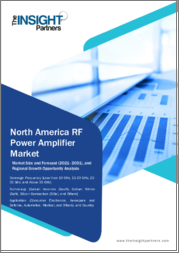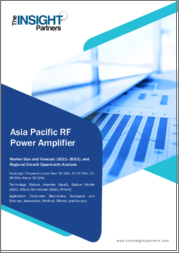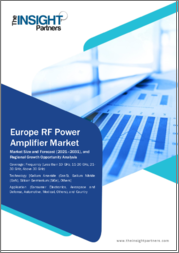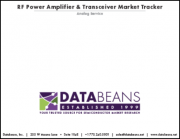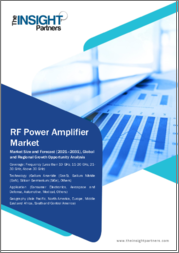
|
시장보고서
상품코드
1456984
세계의 저잡음 증폭기 시장 - 예측(2024-2029년)Global Low Noise Amplifier Market - Forecasts from 2024 to 2029 |
||||||
저잡음 증폭기 시장은 예측 기간 동안 연평균 11.49%의 CAGR로 성장하여 2022년 26억 6,153만 4,000달러에서 2029년 56억 9,839만 달러에 달할 것으로 예상됩니다.
저잡음 증폭기(LNA)는 매우 낮은 강도의 신호를 증폭하는 데 사용할 수있는 전자 증폭기로, 일반적으로 신호가 거의 인식 할 수없는 안테나의 신호를 추가 노이즈없이 증폭해야하며, LNA는 통신 기술의 훌륭한 구성요소입니다. 저잡음 증폭기는 무선 통신 시스템의 수신단에 설치됩니다.
무선통신기술의 급격한 성장으로 저잡음, 고이득, 저전력 소모의 집적 무선주파수 회로에 대한 수요가 증가하고 있으며, LNA는 현대 통신기술의 대표적인 빌딩 블록입니다.
셀룰러 통신에 대한 수요 증가와 5G 기술의 발전과 혁신은 시장 성장을 더욱 촉진하고 있으며, LTE 및 5G 기술의 성장과 함께 스마트폰 기술에 대한 수요 증가는 예측 기간 동안 세계 LNA 시장을 주도하는 주요 요인입니다. 또한 LNA는 ISM 라디오, GPS 수신기, 무선랜, 무선 전화기, 무선 전화기, 위성 통신 시스템, 셀룰러 및 PCS 핸드셋, 자동차 원격 키리스 엔트리 장비에도 사용됩니다.
IoT 상용화, 스마트 자동차 부문 성장, 우주 연구 혁신, 5G 기술 발전 등 신흥국 시장 개척은 시장 호조세를 유지할 것으로 예상됩니다.
시장 촉진요인:
- 스마트폰 수요 증가
스마트폰의 대폭적인 보급과 기술의 세계 확산은 저소음 증폭기 시장을 크게 견인할 것으로 예상됩니다. 네덜란드(98%), 스페인(95%), 스웨덴(94%), 덴마크(93%), 아일랜드(93%), 오스트리아(92%), 룩셈부르크(91%), 키프로스(90%)와 같은 국가에서는 개인의 90% 이상이 인터넷에 접속하기 위해 휴대폰이나 스마트폰에 대한 수요 증가는 분명한 것으로 나타났습니다.
스마트폰에 대한 의존도 증가와 스마트폰 기술의 지속적인 발전은 저소음 증폭기 시장의 성장을 촉진하는 중요한 요인이 될 것으로 보입니다. 소비자 취향의 변화, 원격 근무의 증가, 원격 학습에 대한 지속적인 관심도 스마트폰 판매 확대에 기여할 것으로 예상되는 추가 요인입니다.
- 무선 기술의 성장
스마트폰, 태블릿 및 다양한 모바일 기기에 대한 수요가 증가함에 따라 네트워크 연결이 강화되고, 약한 신호를 증폭하여 안정적인 통신을 보장하는 저잡음 증폭기(LNA)의 필요성이 강조되고 있습니다. 수십억 개의 상호 연결된 기기가 급증하는 사물인터넷(IoT)의 급격한 성장에 따라 효율적인 데이터 전송을 촉진하는 소형의 에너지 효율적인 LNA에 대한 필요성이 증가하고 있습니다.
유럽연합(EU)에 따르면, 현재 진행 중인 연구 개발, 특히 5G와 같은 부문에서의 개발 계획은 전체 산업에서 10조 6,000억 유로에 달할 것으로 예상되며, 2035년까지 이 지역 전체 실질 생산량의 4.6%를 차지할 것으로 예상됩니다. 이러한 수요 급증은 저잡음 증폭기 시장의 중요성을 더욱 부각시키고 있습니다.
시장 억제요인:
- 비용의 복잡성
저잡음 지수가 우수하고 이득이 높은 저잡음 증폭기(LNA)는 종종 고급 재료와 복잡한 제조 공정을 사용해야 하기 때문에 제조 비용이 높아집니다. 비용에 민감한 애플리케이션, 특히 소비자 전자제품 분야에서는 보다 경제적인 대안이 선호되어 고성능 LNA의 보급을 제한할 수 있습니다. 추가 기능을 통합하면 비용이 증가하고 설계가 복잡해질 수 있습니다.
저잡음 증폭기 시장은 주파수별로 <6GHz, 6GHz-60GHz, and>60GHz로 구분됩니다.
저잡음 증폭기(LNA) 시장은 주파수 대역별로 구분되며, 6GHz 이하 주파수 대역에서 작동하는 LNA는 고도로 개발되고 비용 효율성이 상대적으로 높기 때문에 널리 보급되어 있습니다. 이러한 LNA는 이동통신(4G까지), 무선랜, 와이파이, 블루투스, 위성 통신 등 다양한 분야에서 이미 확립된 용도를 가지고 있습니다.
6GHz에서 60GHz 주파수 범위에서는 5G 밀리미터파, 레이더 시스템, 고속 무선 통신 링크와 같은 새로운 기술에서 LNA의 채택이 확대되고 있으며, 60GHz 이상의 주파수에서는 6G, 테라헤르츠 통신, 첨단 레이더 시스템과 같은 고급 애플리케이션에 LNA가 활용되고 있습니다.
아시아태평양은 저잡음 증폭기 시장에서 큰 비중을 차지할 것으로 예상됩니다.
아시아태평양은 기술 발전과 소비자 전자제품의 성장으로 인해 저잡음 증폭기(LNA) 시장에서 중요한 위치를 차지할 것으로 예상됩니다. 소비자 전자제품에 LNA가 널리 사용되고 있어 이 지역의 시장 기회가 더욱 확대되고 있습니다. 또한, 두 개의 주요 성장 국가인 인도와 중국은 LNA 수요를 촉진하는 데 있어 매우 중요한 역할을 할 것으로 예상되며, 전체 시장 성장에 기여할 것으로 예상됩니다.
신흥국 시장 개척
- 2023년 8월 - Musical Fidelity는 강화된 변압기, 업그레이드된 전원 공급 장치 및 최신 저잡음 부품을 탑재한 A1 통합 앰프를 발표했습니다.
- 2023년 6월 - 반도체 집적 설계 및 개발의 선두주자인 pSemi(R) Corporation은 듀얼 채널 스위치가 탑재된 두 가지 멀티칩 모듈을 출시한다고 발표했습니다. 3.5-4.0GHz의 주파수 대역을 지원합니다. 각 모듈은 하이밴드와 로우밴드용으로 설계된 2개의 스위치와 2개의 LNA로 구성됩니다.
목차
제1장 소개
- 시장 개요
- 시장 정의
- 조사 범위
- 시장 세분화
- 통화
- 가정
- 기준 연도와 예측 연도 타임라인
- 관계자에 대한 주요 이점
제2장 조사 방법
- 조사 디자인
- 조사 과정
제3장 주요 요약
- 주요 조사 결과
- 애널리스트의 견해
제4장 시장 역학
- 시장 성장 촉진요인
- 시장 성장 억제요인
- Porter's Five Forces 분석
- 업계 밸류체인 분석
- 애널리스트의 견해
제5장 저잡음 증폭기 세계 시장 : 재료별
- 소개
- 실리콘 게르마늄
- 시장 기회와 동향
- 성장 전망
- 지리적 수익성
- 규소
- 시장 기회와 동향
- 성장 전망
- 지리적 수익성
- 갈륨 비소
- 시장 기회와 동향
- 성장 전망
- 지리적 수익성
- 질화갈륨
- 시장 기회와 동향
- 성장 전망
- 지리적 수익성
제6장 저잡음 증폭기 세계 시장 : 대역별
- 소개
- 6GHz 이하
- 시장 기회 동향
- 성장 전망
- 지리적 매출
- 6GHz
- 시장 기회 동향
- 성장 전망
- 지리적 수익성
- 60GHz 이상
- 시장 기회와 동향
- 성장 전망
- 지리적 수익성
제7장 저잡음 증폭기 세계 시장 : 업계별
- 소개
- 가전
- 시장 기회와 동향
- 성장 전망
- 지리적 수익성
- 의료
- 시장 기회와 동향
- 성장 전망
- 지리적 수익성
- 통신과 기술
- 시장 기회와 동향
- 성장 전망
- 지리적 매출
- 제조업
- 시장 기회와 동향
- 성장 전망
- 지리적 수익성
- 항공우주와 방위
- 시장 기회와 동향
- 성장 전망
제8장 저잡음 증폭기 세계 시장 : 지역별
- 소개
- 북미
- 재료별
- 대역별
- 업계별
- 국가별
- 남미
- 재료별
- 대역별
- 업계별
- 국가별
- 유럽
- 재료별
- 대역별
- 업계별
- 국가별
- 중동 및 아프리카
- 재료별
- 대역별
- 업계별
- 국가별
- 아시아태평양
- 재료별
- 대역별
- 업계별
- 국가별
제9장 경쟁 환경과 분석
- 주요 기업과 전략 분석
- 시장 점유율 분석
- 합병, 인수, 합의와 협업
- 경쟁 대시보드
제10장 기업 개요
- Analog Devices, Inc
- Infineon Technologies AG
- Teledyne Microwave Solutions
- Skyworks Solutions, Inc
- Maxim Integrated
- Future Electronics
- MACOM
- NXP Semiconductors
- Panasonic Corporation
- Qorvo, Inc
- Broadcom(Avago Technologies)
Global Low Noise Amplifier Market is projected to grow at a CAGR of 11.49% during the forecast period to reach US$5,698.39 million by 2029, from US$2,661.534 million in 2022.
A low-noise amplifier or LNA is an electronic amplifier that can be used to amplify signals of very low strength, usually from an antenna where signals are barely recognizable and have to be amplified without adding any further noise. It is an eminent component of communication technology. A low-noise amplifier is provided for the receiving end of a wireless communications system.
Due to the significant growth in wireless communication technology, the demand for integrated radio frequency circuits having low noise, along with high gain, and low power dissipation is increasing. LNAs represent a building block in modern communication technology.
The rising demand for cellular communication and the advancement and innovation in 5G technology are further catalyzing the growth of the market. The rising demand for smartphone technology coupled with the growth of LTE and 5G technology is a key reason driving the global LNA market during the projected period. Furthermore, LNAs are also used in ISM radios, GPS receivers, wireless LANs, cordless phones, satellite communication systems, cellular and PCS handsets, and automotive remote keyless entry devices.
The developments in the form of commercialization of the IoT, growth in the smart automotive sector, innovation in space research, and the advancement of 5G technology are expected to hold the market in good stead.
Market Drivers:
- Increasing demand for smartphones-
The substantial surge in smartphone adoption and the global proliferation of technology are anticipated to significantly drive the low-noise amplifier market. The escalating demand for smartphones is evident, with over 90% of individuals using mobile or smart devices to access the internet in countries such as the Netherlands (98%), Spain (95%), Sweden (94%), Denmark (93%), Ireland (93%), Austria (92%), Luxembourg (91%), and Cyprus (90%).
This increasing reliance on smartphones, coupled with continuous advancements in smartphone technology, is poised to be a key factor propelling the expansion of the low-noise amplifier market. Factors such as evolving consumer preferences, the rise of remote work, and the sustained emphasis on remote learning are additional elements expected to contribute to increased smartphone sales.
- Growing wireless technology-
The escalating demand for smartphones, tablets, and various mobile devices, all requiring enhanced network connectivity, underscores the necessity for Low-Noise Amplifiers (LNAs) to amplify weak signals, ensuring reliable communication. With the exponential growth of the Internet of Things (IoT), marked by the proliferation of billions of interconnected devices, there is a substantial need for compact and energy-efficient LNAs to facilitate efficient data transmission.
According to the European Union (EU), ongoing research, development, and deployment initiatives, particularly in areas like 5G, are projected to reach €10.6 trillion across industries. By 2035, this is expected to constitute 4.6% of the entire global real output in the region. This surge in demand further underscores the significance of the low-noise amplifier market.
Market Restraint:
- Cost complexity-
Low Noise Amplifiers (LNAs) with superior noise figures and high gains often necessitate the use of advanced materials and intricate fabrication processes, contributing to elevated production costs. In applications where cost sensitivity is paramount, especially within the consumer electronics sector, there may be a preference for more economical alternatives, thereby restricting the widespread adoption of high-performance LNAs. The integration of additional functionalities can compound costs and introduce greater complexity to the design.
Global low noise amplifier market is segmented by frequency into <6 GHz, 6GHz-60GHz, and >60GHz.
The Global Low Noise Amplifier (LNA) Market is segmented based on frequency bands. LNAs operating at frequencies below 6 GHz are highly developed and comparatively cost-effective, resulting in widespread accessibility. These LNAs find established applications across various sectors, including mobile communication (up to 4G), wireless LANs, Wi-Fi, Bluetooth, and satellite communication.
In the frequency range of 6 GHz to 60 GHz, there is a growing adoption of LNAs in emerging technologies such as 5G mm-wave, radar systems, and high-speed wireless communication links. For frequencies exceeding 60 GHz, LNAs are utilized in advanced applications like 6G, terahertz communication, and sophisticated radar systems.
APAC is anticipated to hold a significant share of the Low noise amplifiers market.
The Asia-Pacific region is poised to hold a significant position in the Low-Noise Amplifiers (LNAs) market, driven by technological advancements and the flourishing consumer electronics sector. The extensive use of LNAs in consumer electronics products further enhances the market opportunities in the region. Additionally, the two largest growing economies, India and China, are anticipated to play a pivotal role in driving the demand for LNAs, contributing to the overall market growth.
Market Developments:
- August 2023- Musical Fidelity introduced the A1 integrated amplifier, featuring an enhanced transformer, upgraded power supplies, and modern low-noise components.
- June 2023- pSemi(R) Corporation, a Murata company at the forefront of semiconductor integration design and development, announced the launch of two multi-chip modules featuring dual-channel switches. The PE53230 catered to the 3.3-3.8 GHz frequency range, while the PE53231 addressed the 3.5-4.0 GHz range. Each module comprised two switches and two LNAs designed for high- and low-band frequencies.
Market Segmentation:
By Material
- Silicon-germanium
- Silicon
- Gallium Arsenide
- Gallium Nitride
By Frequency
- <6 Ghz
- 6ghz-60ghz
- >60ghz
By Industry Vertical
- Consumer Electronics
- Healthcare
- Communications And Technology
- Manufacturing
- Aerospace And Defence
By Geography
- North America
- USA
- Canada
- Mexico
- South America
- Brazil
- Argentina
- Others
- Europe
- UK
- Germany
- France
- Italy
- Spain
- Others
- Middle East and Africa
- Saudi Arabia
- UAE
- Israel
- Others
- Asia Pacific
- China
- Australia
- Japan
- India
- South Korea
- Indonesia
- Taiwan
- Thailand
- Others
TABLE OF CONTENTS
1. INTRODUCTION
- 1.1. Market Overview
- 1.2. Market Definition
- 1.3. Scope of the Study
- 1.4. Market Segmentation
- 1.5. Currency
- 1.6. Assumptions
- 1.7. Base, and Forecast Years Timeline
- 1.8. Key benefits to the stakeholder
2. RESEARCH METHODOLOGY
- 2.1. Research Design
- 2.2. Research Process
3. EXECUTIVE SUMMARY
- 3.1. Key Findings
- 3.2. Analyst View
4. MARKET DYNAMICS
- 4.1. Market Drivers
- 4.2. Market Restraints
- 4.3. Porter's Five Forces Analysis
- 4.3.1. Bargaining Power of Suppliers
- 4.3.2. Bargaining Power of Buyers
- 4.3.3. Threat of New Entrants
- 4.3.4. Threat of Substitutes
- 4.3.5. Competitive Rivalry in the Industry
- 4.4. Industry Value Chain Analysis
- 4.5. Analyst View
5. GLOBAL LOW NOISE AMPLIFIER MARKET BY MATERIAL
- 5.1. Introduction
- 5.2. Silicon-Germanium
- 5.2.1. Market opportunities and trends
- 5.2.2. Growth prospects
- 5.2.3. Geographic lucrativeness
- 5.3. Silicon
- 5.3.1. Market opportunities and trends
- 5.3.2. Growth prospects
- 5.3.3. Geographic lucrativeness
- 5.4. Gallium Arsenide
- 5.4.1. Market opportunities and trends
- 5.4.2. Growth prospects
- 5.4.3. Geographic lucrativeness
- 5.5. Gallium Nitride
- 5.5.1. Market opportunities and trends
- 5.5.2. Growth prospects
- 5.5.3. Geographic lucrativeness
6. GLOBAL LOW NOISE AMPLIFIER MARKET BY FREQUENCY
- 6.1. Introduction
- 6.2. <6 GHz
- 6.2.1. Market opportunities and trends
- 6.2.2. Growth prospects
- 6.2.3. Geographic lucrativeness
- 6.3. 6GHz-60GHz
- 6.3.1. Market opportunities and trends
- 6.3.2. Growth prospects
- 6.3.3. Geographic lucrativeness
- 6.4. >60GHz
- 6.4.1. Market opportunities and trends
- 6.4.2. Growth prospects
- 6.4.3. Geographic lucrativeness
7. GLOBAL LOW NOISE AMPLIFIER MARKET BY INDUSTRY VERTICAL
- 7.1. Introduction
- 7.2. Consumer Electronics
- 7.2.1. Market opportunities and trends
- 7.2.2. Growth prospects
- 7.2.3. Geographic lucrativeness
- 7.3. Healthcare
- 7.3.1. Market opportunities and trends
- 7.3.2. Growth prospects
- 7.3.3. Geographic lucrativeness
- 7.4. Communications and Technology
- 7.4.1. Market opportunities and trends
- 7.4.2. Growth prospects
- 7.4.3. Geographic lucrativeness
- 7.5. Manufacturing
- 7.5.1. Market opportunities and trends
- 7.5.2. Growth prospects
- 7.5.3. Geographic lucrativeness
- 7.6. Aerospace and Defence
- 7.6.1. Market opportunities and trends
- 7.6.2. Growth prospects
8. GLOBAL LOW NOISE AMPLIFIER MARKET BY GEOGRAPHY
- 8.1. Introduction
- 8.2. North America
- 8.2.1. By Material
- 8.2.2. By Frequency
- 8.2.3. By Industry Vertical
- 8.2.4. By Country
- 8.2.4.1. United States
- 8.2.4.1.1. Market Trends and Opportunities
- 8.2.4.1.2. Growth Prospects
- 8.2.4.2. Canada
- 8.2.4.2.1. Market Trends and Opportunities
- 8.2.4.2.2. Growth Prospects
- 8.2.4.3. Mexico
- 8.2.4.3.1. Market Trends and Opportunities
- 8.2.4.3.2. Growth Prospects
- 8.2.4.1. United States
- 8.3. South America
- 8.3.1. By Material
- 8.3.2. By Frequency
- 8.3.3. By Industry Vertical
- 8.3.4. By Country
- 8.3.4.1. Brazil
- 8.3.4.1.1. Market Trends and Opportunities
- 8.3.4.1.2. Growth Prospects
- 8.3.4.2. Argentina
- 8.3.4.2.1. Market Trends and Opportunities
- 8.3.4.2.2. Growth Prospects
- 8.3.4.3. Others
- 8.3.4.3.1. Market Trends and Opportunities
- 8.3.4.3.2. Growth Prospects
- 8.3.4.1. Brazil
- 8.4. Europe
- 8.4.1. By Material
- 8.4.2. By Frequency
- 8.4.3. By Industry Vertical
- 8.4.4. By Country
- 8.4.4.1. Germany
- 8.4.4.1.1. Market Trends and Opportunities
- 8.4.4.1.2. Growth Prospects
- 8.4.4.2. France
- 8.4.4.2.1. Market Trends and Opportunities
- 8.4.4.2.2. Growth Prospects
- 8.4.4.3. United Kingdom
- 8.4.4.3.1. Market Trends and Opportunities
- 8.4.4.3.2. Growth Prospects
- 8.4.4.4. Italy
- 8.4.4.4.1. Market Trends and Opportunities
- 8.4.4.4.2. Growth Prospects
- 8.4.4.5. Spain
- 8.4.4.5.1. Market Trends and Opportunities
- 8.4.4.5.2. Growth Prospects
- 8.4.4.6. Others
- 8.4.4.6.1. Market Trends and Opportunities
- 8.4.4.6.2. Growth Prospects
- 8.4.4.1. Germany
- 8.5. Middle East and Africa
- 8.5.1. By Material
- 8.5.2. By Frequency
- 8.5.3. By Industry Vertical
- 8.5.4. By Country
- 8.5.4.1. Saudi Arabia
- 8.5.4.1.1. Market Trends and Opportunities
- 8.5.4.1.2. Growth Prospects
- 8.5.4.2. UAE
- 8.5.4.2.1. Market Trends and Opportunities
- 8.5.4.2.2. Growth Prospects
- 8.5.4.3. Israel
- 8.5.4.3.1. Market Trends and Opportunities
- 8.5.4.3.2. Growth Prospects
- 8.5.4.4. Others
- 8.5.4.4.1. Market Trends and Opportunities
- 8.5.4.4.2. Growth Prospects
- 8.5.4.1. Saudi Arabia
- 8.6. Asia Pacific
- 8.6.1. By Material
- 8.6.2. By Frequency
- 8.6.3. By Industry Vertical
- 8.6.4. By Country
- 8.6.4.1. China
- 8.6.4.1.1. Market Trends and Opportunities
- 8.6.4.1.2. Growth Prospects
- 8.6.4.2. Australia
- 8.6.4.2.1. Market Trends and Opportunities
- 8.6.4.2.2. Growth Prospects
- 8.6.4.3. Japan
- 8.6.4.3.1. Market Trends and Opportunities
- 8.6.4.3.2. Growth Prospects
- 8.6.4.4. South Korea
- 8.6.4.4.1. Market Trends and Opportunities
- 8.6.4.4.2. Growth Prospects
- 8.6.4.5. India
- 8.6.4.5.1. Market Trends and Opportunities
- 8.6.4.5.2. Growth Prospects
- 8.6.4.6. Thailand
- 8.6.4.6.1. Market Trends and Opportunities
- 8.6.4.6.2. Growth Prospects
- 8.6.4.7. Taiwan
- 8.6.4.7.1. Market Trends and Opportunities
- 8.6.4.7.2. Growth Prospects
- 8.6.4.8. Indonesia
- 8.6.4.8.1. Market Trends and Opportunities
- 8.6.4.8.2. Growth Prospects
- 8.6.4.9. Others
- 8.6.4.9.1. Market Trends and Opportunities
- 8.6.4.9.2. Growth Prospects
- 8.6.4.1. China
9. COMPETITIVE ENVIRONMENT AND ANALYSIS
- 9.1. Major Players and Strategy Analysis
- 9.2. Market Share Analysis
- 9.3. Mergers, Acquisition, Agreements, and Collaborations
- 9.4. Competitive Dashboard
10. COMPANY PROFILES
- 10.1. Analog Devices, Inc
- 10.2. Infineon Technologies AG
- 10.3. Teledyne Microwave Solutions
- 10.4. Skyworks Solutions, Inc
- 10.5. Maxim Integrated
- 10.6. Future Electronics
- 10.7. MACOM
- 10.8. NXP Semiconductors
- 10.9. Panasonic Corporation
- 10.10. Qorvo, Inc
- 10.11. Broadcom (Avago Technologies)









